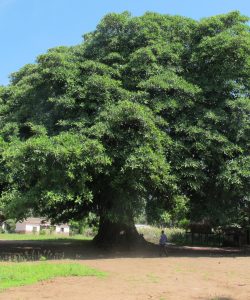
Botanical Name: Ficus bussei
Common Name: Zambezi Fig, Mutowe, Citowe
Plant Family: Moraceae (Fig Family)
Growth Form, Habitat and Distribution: Very large evergreen or semi-deciduous tree, with a rounded wide spreading crown, starting as a strangler with adventitious roots from lateral branches thickening to become supporting pillars. Common on alluvial terraces in the major river valleys in the eastern and southern parts of Zambia.
Size: Height: up to 18m, spread up to 36m.
Bark: Grey – brown, roughish, flaking in chunks, finely longitudinally fissured. Latex is exuded if damaged.
Leaves: Spirally arranged, ovate, oblong, or elliptic, up to 24cm, dark green above, paler below, velvety, paired veins from the base, apex usually acute, base heavily lobed, margin entire. Petiole 2 to 8cm.
Flowers: September to February. Flowering parts are internal to fruit.
Fruit: Borne 1 or 2 on leaf axils, or clusters on branches, with stalks, round, up to 2.5cm, yellow green with cream spots on raised warts, velvety, yellow when ripe. October to April.
Uses: Fruits are eaten by humans and favoured by fruit eating birds, bats and monkeys. The latex is used to treat conjunctivitis and burns. Good shade tree where there is adequate space, but is not frost hardy.
